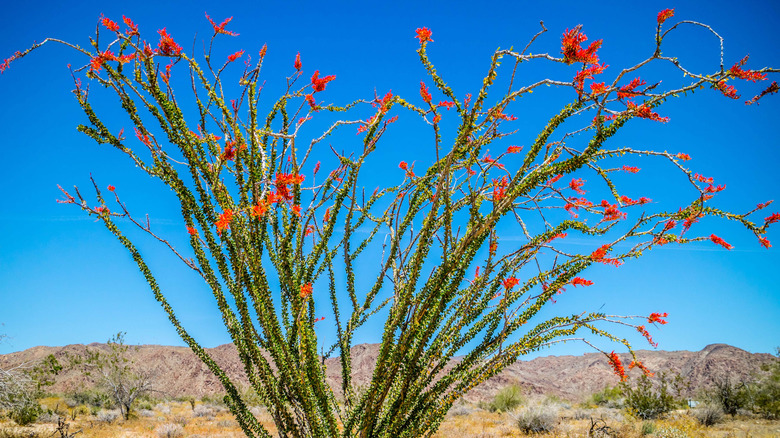The Drought-Tolerant Plant That Could Survive Any Hot Yard
Desert landscaping brings a set of challenges that gardeners in more verdant regions don't have to consider. Low rainfall totals limit your choices to drought-tolerant plants and hardscaping with rocks, patios, or pavers, unless you have the resources for near-constant watering or access to an irrigation specialist. One remarkable plant, the ocotillo (Fouqeieria spendens), can appear almost dead until it rains. With a douse of water, vivid, red-orange flowers spring from the tips of the plant's long, spiny canes while green leaves sprout along their length. The foliage and tubular flowers can last for about a month before the deciduous bush returns to its colorless state. Ocotillo will entice pollinators attracted by the flower's nectar, such as hummingbirds and bees. You can also pair them with other drought-tolerant plants that thrive without much water like creosote bush (Larrea tridentata) and night-blooming cereus (Peniocereus greggii).
Despite its desert habitat and thorn-covered stems, ocotillo is technically a shrub, not a cactus. Hardy in USDA zones 8 to 10, the spindly plant adorned with inch-and-a-half-long spikes thrives in the Chihuahuan and Sonoran deserts of the American Southwest, growing up to 30 feet tall. Ocotillo requires heat and well-drained soil to survive, but can tolerate temperatures as low as 10 degrees Fahrenheit. The Yavapai, Pima, and other Native American peoples eat the flowers of ocotillo, make tea with them, and use the seeds to make high protein flour. The plants also have a long history of being used as natural fences.
Growing ocotillo in your hot yard
March through May is the best time to plant drought-tolerant plants, including ocotillo. However, they can still be planted year-round in full sun and sandy or loamy well-drained soil. Dig a hole that is just wide and deep enough to contain the root system. If you know what the original orientation of the plant was, if, for instance, you're using a transplant from a neighbor's yard rather than a nursery plant, replant it in the same orientation — the north-facing side of the plant should still face north in its new location. Test the hole's drainage by filling it with water and waiting for the water to completely seep into the surrounding soil. If it takes less than an hour, it's a good spot for the ocotillo.
Once you've planted ocotillo, stick to a very spare watering schedule until the plant is established, which may take a few months to two years for transplants, or less for nursery plants. Water the transplant once a week in the summer and twice a month in the winter. You should not need to water the ocotillo after it's established unless you're in a severe drought. Because ocotillo blooms at the tips of the stems, they shouldn't need to be pruned unless there's a dead section or a stem that's gotten too tall.
Ocotillo is a protected native plant in Arizona, so its removal or transplantation can be regulated by the state, even if it's on your own property. Check with your state's Department of Agriculture before disturbing the plant.

